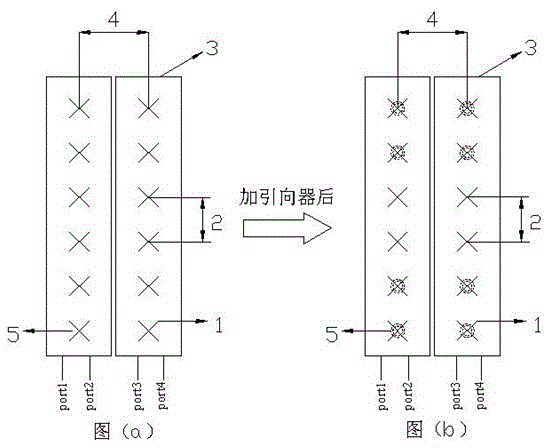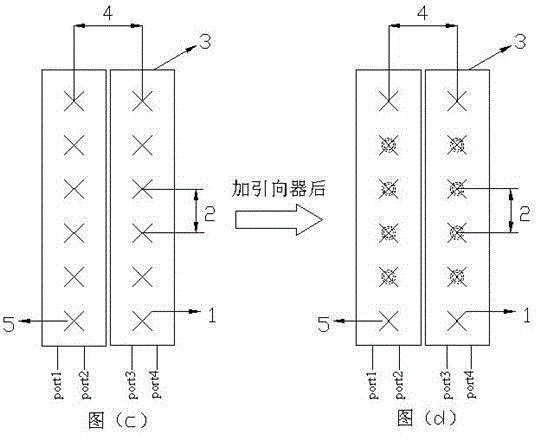LTE (Long Term Evolution) frequency band multi-antenna-array gain compensation method
A technology of array gain and compensation method, which is applied in antenna arrays, antennas, electrical components, etc., can solve the problems of low frequency point gain, unsatisfactory effect, and increased antenna size
- Summary
- Abstract
- Description
- Claims
- Application Information
AI Technical Summary
Problems solved by technology
Method used
Image
Examples
Embodiment 1
[0050] Embodiment 1, as shown in Figure 2, is the first application scheme of the present invention.
[0051] As for the picture (a), it is an LTE band multi-antenna array that supports 1710-2690MHz frequency band. It consists of two columns of ±45° dual-polarized base station antennas, including four antenna input or output ports, port1, port2, port3, and port4. Each column antenna is composed of six radiating oscillators 1 with a spacing of 2 and a spacing of 4 between columns. Any one of the two columns includes a reflector 3 and a feed network installed behind the reflector. The vibrators are arranged from top to bottom, corresponding to No. 1-1, No. 1-2, No. 1-3, No. 1-4, No. 1-5, and No. 1-6 in the first row, and No. 2-1 in the second row. , No. 2-2, No. 2-3, No. 2-4, No. 2-5, and No. 2-6 oscillators, the power distribution of any row of oscillators is the same, and the specific ratio is P 1 :P 2 :P 3 :P 4 :P 5 :P 6 , and, P 1 2 3 =P 4 >P 5 >P 6 .
[0052] Af...
Embodiment 2
[0056] As shown in Figure 3, it is the second application scheme of the present invention.
[0057] As for the picture (c), it is an LTE band multi-antenna array that supports 1710-2690MHz frequency band. It consists of two columns of ±45° dual-polarized base station antennas, including four antenna input or output ports, port1, port2, port3, and port4. Each column antenna is composed of six radiating oscillators 1 with a spacing of 2 and a spacing of 4 between columns. Any one of the two columns includes a reflector 3 and a feed network installed behind the reflector. The vibrators are arranged from top to bottom, corresponding to No. 1-1, No. 1-2, No. 1-3, No. 1-4, No. 1-5, and No. 1-6 in the first row, and No. 2-1 in the second row. , No. 2-2, No. 2-3, No. 2-4, No. 2-5, and No. 2-6 oscillators, the power distribution of any row of oscillators is the same, and the specific ratio is P 1 :P 2 :P 3 :P 4 :P 5 :P 6 , and, P 1 2 3 =P 4 >P 5 >P 6 .
[0058] After the di...
PUM
 Login to View More
Login to View More Abstract
Description
Claims
Application Information
 Login to View More
Login to View More - R&D
- Intellectual Property
- Life Sciences
- Materials
- Tech Scout
- Unparalleled Data Quality
- Higher Quality Content
- 60% Fewer Hallucinations
Browse by: Latest US Patents, China's latest patents, Technical Efficacy Thesaurus, Application Domain, Technology Topic, Popular Technical Reports.
© 2025 PatSnap. All rights reserved.Legal|Privacy policy|Modern Slavery Act Transparency Statement|Sitemap|About US| Contact US: help@patsnap.com



